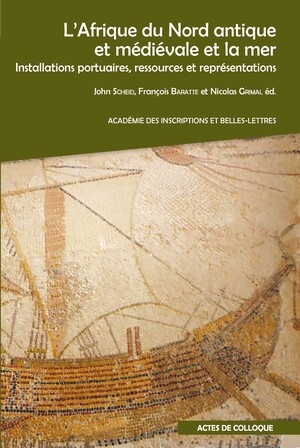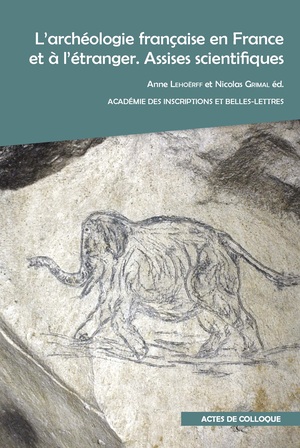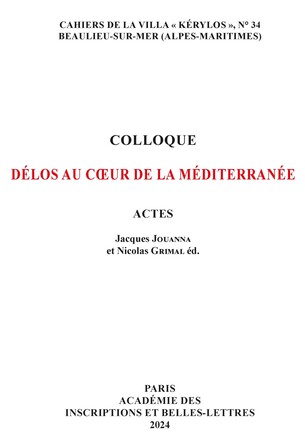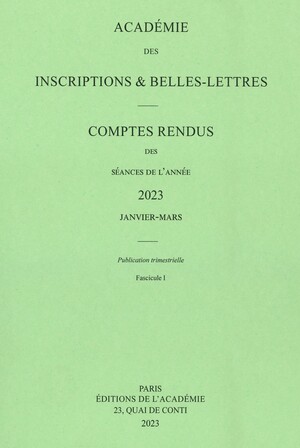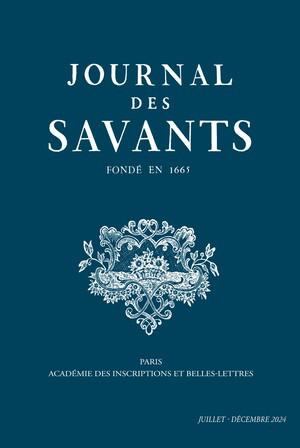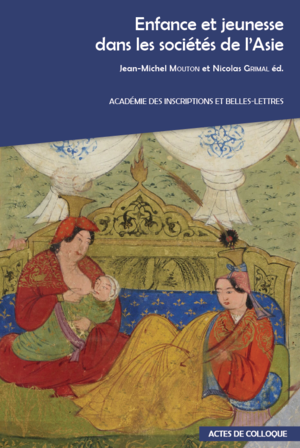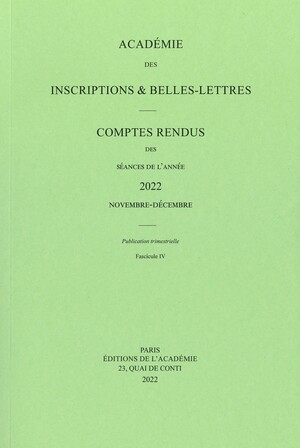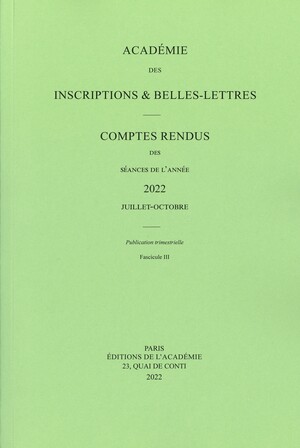Publications Archivum Latinitatis Medii Aevi, 79, 2021
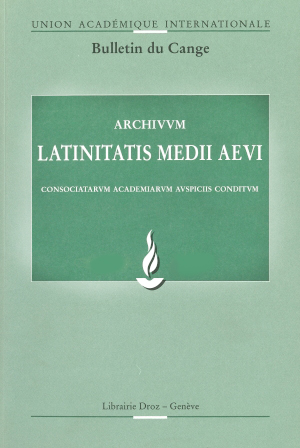
Archivum Latinitatis Medii Aevi, 79, 2021
Date : 2021
346 pages.
Pour se procurer ces périodiques :
Librairie Droz, 11 rue Massot Case Postale 389
1211 Genève 12 – Suisse
Tél : +41 22 346 66 66 ; Fax : +41 22 347 23 91
Site : www.droz.org
Courriel : droz@droz.org
Présentation
Actes du colloque VOCES 2021. Fêtes et célébrations. Centenaire du « Dictionnaire du Latin médiéval », Campus Condorcet (Aubervilliers), 29 septembre-1er octobre 2021
Bon B., Guerreau-Jalabert A., Leithe-Jasper H., Nowak K., Introduction, p. 7-8, Schmitt J.-Cl., Les rythmes de la fête au Moyen Âge, p. 9-29
Résumé. – Après un rapide bilan des études sociologiques, anthropologiques et historiques concernant la fête (entendue au sens le plus large possible de toutes les manifestations portant en latin ou dans une langue vernaculaire le nom de « fête »), l’article propose de partir, de manière régressive, de la critique révolutionnaire – en 1789 – du rythme des fêtes d’Ancien Régime (Mona Ozouf) pour n’en venir qu’ensuite aux fêtes médiévales de toutes sortes, liturgiques, mais aussi princières ou villageoises. Les rythmes festifs ont pour caractéristiques la périodicité et aussi la variation (voire l’arythmie), en évitant toujours la simple répétition. Cette observation vaut autant pour la succession des fêtes dans le cycle de l’année que pour le déroulement de chaque fête dans sa durée propre. L’inventaire des fêtes étant par nature infini, l’étude se concentre sur un nombre limité d’exemples, notamment les fêtes de bachellerie étudiées naguère par Nicole Pellegrin ou plus récemment les fêtes médiévales (de France, Italie, Allemagne, Espagne) analysées dans un numéro spécial de la revue Questes.
Abstract. − After a rapid review of sociological, anthropological and historical studies concerning the feast or festival (understood in the broadest possible sense of all events bearing such names in Latin or in a vernacular language), the article proposes to start, in a regressive manner, from the revolutionary criticism – in 1789 – of the rhythm of the Ancien Régime feasts (Mona Ozouf) to come only then to medieval festivals of all kinds, liturgical, but also princely or village ones. Festive rhythms are characterized by periodicity and also by variation (even arrhythmia), always avoiding simple repetition. This observation applies as much to the succession of feasts in the cycle of the year as to the unfolding of each one in its own duration. The inventory of feasts being by nature infinite, the study concentrates on a limited number of examples, notably the bachelors’ feasts studied by Nicole Pellegrin or more recently the medieval feasts (of France, Italy, Germany, Spain) analyzed in a special issue of the review Questes.
Zusammenfassung. − Nach einer kurzen Bilanz der soziologischen, anthropologischen und historischen Studien zum Fest (im weitesten Sinne verstanden als alle Veranstaltungen, die im Lateinischen oder in einer Volkssprache den Namen «Fest» tragen), schlägt der Artikel vor, regressiv von der revolutionären Kritik – im Jahr 1789 – am Rhythmus der Feste des Ancien Régime (Mona Ozouf) auszugehen und erst danach zu den mittelalterlichen Festen aller Art, liturgischen, aber auch fürstlichen oder dörflichen, zu kommen. Die festlichen Rhythmen zeichnen sich durch Periodizität und Variation (oder sogar Arrhythmie) aus, wobei eine einfache Wiederholung stets vermieden wird. Dies gilt sowohl für die Abfolge der Feste im Jahreszyklus als auch für den Ablauf jedes Festes innerhalb seiner eigenen Dauer. Da das Inventar der Feste naturgemäß unendlich ist, konzentriert sich die Studie auf eine begrenzte Anzahl von Beispielen, insbesondere die von Nicole Pellegrin früher untersuchten bachellerie-Feste oder in jüngerer Zeit die mittelalterlichen Feste (aus Frankreich, Italien, Deutschland, Spanien), die in einer Sonderausgabe der Zeitschrift Questes analysiert wurden.
Ottelli J., Creare la « machinam » : idee politiche e pratiche di governo nella musica dei Visconti, p. 31-41
Riassunto. – Nell’ambito della nascita delle signorie italiche del Trecento, il caso di Milano e dei Visconti spicca come uno tra i più indagati. In origine, i membri del casato dovettero inserirsi nell’alveo di una solida tradizione comunale, per eroderne le prerogative e instaurare un governo monocratico. Allo scopo servirono certamente le politiche culturali adottate dall’agnazione e, all’interno di queste, si possono trovare delle composizioni musicali come madrigali e mottetti, ideate allo scopo di presentare i Visconti e le loro virtù come meritevoli a renderli guida della comunità. Queste composizioni si caratterizzano per la presenza, al loro interno, di chiari riferimenti sia alle nobili doti dei governanti, sia alle loro aspirazioni e pratiche in ambito politico. Il presente saggio si concentra appunto su una di queste composizioni, il mottetto Lux porpurata radiis, composto da Jacopo da Bologna per Luchino Visconti nella prima metà del Quattordicesimo secolo. Rompendo la tradizione, il mottetto presenta l’allocuzione Diligite iusticiam con un nuovo termine: machinam. Cosa significhi all’interno del testo e dove sia possibile collocarla in relazione alle politiche culturali del Visconti sono due delle domande alla base di questo studio.
Abstract. – In the framework of the development of the lordships in the Italian peninsula, the case of the Visconti duchy of Milan certainly appears as one of the most fascinating. Visconti rulers aimed to be introduced into a well-known communal tradition to corrode its prerogatives, in favor of a centralization of powers. Performed in the circle of the court during feasts, madrigals and motets served the purpose of celebrating the virtues of the new lords to make them more easily accepted by the community. In these multi-voice musical pieces, clear references to the politics of the Milanese dukes are hidden in acrostic forms. This essay focuses on a single word, written in the motet Lux porpurata radiis, composed by Jacopo da Bologna in the first half of the fourteenth century. Breaking the tradition, the piece presents the allocution Diligite iusticiam with a new term: machinam. What does the word machinam relate to and where can we place it in Luchino Visconti’s cultural policies, are the two main issues underlying this essay.
Belgrano A., Choreas ducere : dire l’acte de danser en groupe au Moyen Âge, p. 43-58
Résumé. – Le vocabulaire médiéval de la danse, n’étant pas unifié sous une catégorie générique que nous nommons aujourd’hui la « danse », est composé d’une série de termes fonctionnant en système. Au sein de la version latine de ce système, le couple de mots chorus/chorea possède deux particularités : il désigne la danse de groupe et ne dérive pas d’un verbe. Aussi, le latin classique doit-il recourir à la construction choros / choreas ducere pour désigner l’action correspondante, à savoir danser en groupe. Cet article tente d’en faire l’histoire à grands traits, de ses origines à son déclin à la fin du Moyen Âge. Il s’efforce aussi d’en dégager le sens, ambigu, d’expliquer les différences d’utilisation entre chorus et chorea mais également de prendre en considération les autres tentatives d’exprimer l’action de danser en groupe. Une attention particulière sera notamment accordée au verbe chorizare, apparu durant le Moyen Âge central, à une époque où les textes en langue romane voient le développement parallèle de la carole.
Abstract. – The medieval vocabulary of dance, not being unified under a generic category that we today call «dance», is made up of a series of terms operating as a system. Within the Latin version of this system, the pair of words chorus/chorea presents two distinctive points: it refers to group dance and does not derive from a verb. Thus, Classical Latin had to use the construction choros/choreas ducere to denote the corresponding action, that is «group dancing». This article aims to sketch its history, from its origins to its decline in the course of the Late Middle Ages. It also tries to clear its ambiguous meaning, to explain the differences in the use of chorus and chorea, and to consider the various attempts to express «group dancing» as well. The verb chorizare, which appeared during the High Middle Ages, at a time when texts in Romance languages witnessed a parallel expansion of the term carole, will receive particular attention.
Fornés Pallicer M. A., Quetglas Nicolau P. J., La celebración de pequeñas y grandes fiestas en la documentación latina de la Cataluña altomedieval, p. 59-76
Resumen. – Este trabajo se propone analizar la documentación latina de la Cataluña altomedieval con el fin de detectar en ella la existencia de celebraciones festivas y obtener información sobre estas. Con este propósito se realiza un análisis de los elementos léxicos asociados a dos características esenciales de las celebraciones: la confluencia de un gran número de gente y el banquete. Así, por una parte, se indaga en el uso de términos como, entre otros, caterua, coetus, concursus, conglobatio, congregatio o multitudo, que se relacionan con los asistentes; y, por otra parte, en lo que respecta a la comida en tanto que ligada a la celebración, se analizan términos como reficio, refectio, conuiuium, caritas, cena o prandium.
Abstract. – This paper aims to analyse documentation in Latin from early mediaeval Catalonia, with a view to uncovering the existence of festive events and any information about them. To do this, we perform an analysis of lexical elements linked to two fundamental features of events: the gathering of large groups of people and banquets. Thus, an initial exploration is undertaken into the use of terms associated with attendees, such as caterua, coetus, concursus, conglobatio, congregatio or multitudo. This is then followed by an analysis of meal terms associated with celebrations, including reficio, refectio, conuiuium, caritas, cena and prandium.
Hamel S., Les enjeux socio-économiques des jours fériés à la fin du Moyen Âge : l’exemple d’un procès au Parlement de Paris entre la ville et le chapitre de Saint-Quentin, p. 77-91
Résumé. – Du lundi 30 décembre 1443 au jeudi 30 janvier 1444 se tient au Parlement de Paris un procès opposant le maire, les jurés et les échevins au doyen et au chapitre collégial de la ville de Saint-Quentin. L’enjeu est de déterminer laquelle des deux parties a le droit de réglementer le commerce et le travail lors des jours fériés. Les prémisses de ce procès permettent d’illustrer le problème de façon concrète, principalement en le quantifiant, c’est-à-dire en mesurant l’incidence des jours fériés sur la vie économique de la ville de Saint-Quentin.
Abstract. – From Monday, December 30, 1443 to Thursday, January 30, 1444, a trial was held in the Parliament of Paris between the mayor, the jurors and the aldermen against the dean and collegiate chapter of the town of Saint-Quentin. The issue was to determine which of the two parties had the right to regulate trade and labor on public holidays. The example of this trial makes it possible to illustrate the problem in a concrete way mainly by quantifying it, i.e. by measuring the impact of public holidays on the economic life of Saint-Quentin.
Pörnbacher M., De centesimo anno : « annus iubileus » und Jubiläum von Dhuoda bis Dante, p. 93-109
Zusammenfassung. — Ausgehend von Dhuoda, Liber manualis 6,4,24 (ed. Pierre Riché) « qui (annus iubileus) etiam remissus et absolutus intelligitur », wird anhand von Beispielen aus dem AT, dem NT und aus mittelalterlichen Quellen der Verwendung und Bedeutung von Jubeljahr und Jubiläum nachgespürt, bis hin zum Heiligen Jahr, das Papst Bonifaz VIII. im Jahr 1300 ausrief (Bulle Antiquorum habet fida relatio), was in Iacopo Stefaneschis Schrift De centesimo seu iubileo anno eine literarische Dokumentation fand. Die historische Entwicklung zu neuen Riten und religiösen Bräuchen kann auch aus sprachlicher Sicht beleuchtet werden. Dante und die Brüder Villani etwa sprechen je auf ihre Art vom Heiligen Jahr. Die Abstände zwischen Jubel- oder Heiligen Jahren, 50 oder 25 Jahre und ihre Vielfachen, werden zum Zeitmaß für geistliche und säkulare Jubelfeiern, die im ausgehenden 18. Jh. einen Höhepunkt finden. – Mit einem Ausblick auf den Satz « Il Giubileo » aus dem Zyklus Feste Romane von Ottorino Respighi klingt die Gratulation für die Kollegen in Paris zum Jubiläum ihres Projektes an.
Abstract. — The present contribution was inspired by an observation of considerable significance by Dhuoda, Liber manualis 6,4,24 (ed. Pierre Riché) «qui (annus iubileus) etiam remissus et absolutus intelligitur». Examples from the Old Testament, the New Testament and medieval sources illustrate the use and sense of jubilee year and jubilee, up to the Holy Year proclaimed by Pope Boniface VIII in 1300 (Bull Antiquorum habet fida relatio) and documented by Iacopo Stefaneschi in his work De centesimo seu iubileo anno. The historical development of new rites and religious customs can likewise be considered from a linguistic point of view. Dante and the Villani brothers, for instance, write each in their own manner about the jubilee. The periods between jubilees, 50 or 25 years and their multiples, become a measure of time for religious and secular commemorations, reaching a high point at the end of the 18th century. – In referring to the movement «Il Giubileo» from the cycle Feste Romane composed by Ottorino Respighi, we express our sincere congratulations to our colleagues in Paris in occasion of the centenary of their project.
Silagiová Z., (Un)erwünschte Bräuche oder koleda und pomlázka, p. 111-133
Zusammenfassung. – Der Beitrag befasst sich mit zwei Volksbräuchen, die mit religiösen Festen verbunden sind und deren Namen und Beschreibungen sich im Material des mittellateinischen Wörterbuchs in Böhmen und Mähren (Latinitatis medii aevi lexicon Bohemorum) finden. Der Name des ersten, kalenda, hat seinen Ursprung in der römischen Bezeichnung für den ersten Tag des Monats. Der Brauch findet in der Weihnachtszeit statt und wird als feierlichen Rundgang mit Gesang durchgeführt; unter demselben Namen ist er im polnischen mittellateinischen Wörterbuch dokumen- tiert; Alt- und Neutschechisch kennen ihn als koleda. Der zweite Brauch ist ein rituelles Auspeitschen, das zu Ostern erfolgt und nur unter seinen vernakularen Namen (tschechisch pomlázka, deutsch schmackostern) bekannt ist. Beide Bräuche enthalten eine heidnische Symbolik, die später der christlichen Lehre angepasst wurde. Der Beitrag erörtert die Begriffe anhand lexikographischer Methoden, untersucht ihre Etymologie und Bedeutung und verfolgt semantische Veränderungen; die Ergebnisse werden durch Beispiele aus mittelalterlichen Quellen böhmischer Provenienz belegt.
Abstract. –The paper deals with two folk customs associated with religious festivals and whose names and descriptions are found in the material of the Dictionary of Medieval Latin in Bohemia and Moravia (Latinitatis medii aevi lexicon Bohemorum). The name of the first custom, kalenda, has its origin in the Roman name of the first day of the month. The custom takes place during Christmas and is performed as a ceremonial tour with singing; it is documented under the same name in the Polish dictionary of Medieval Latin; Old and New Czech know it as koleda. The second custom is a ritual beating, which takes place at Easter, and is known only by its vernacular name (Czech pomlázka, German schmackostern). Both customs contain pagan symbolism that was later adapted to Christian doctrine. The paper discusses the terms using lexicographical methods, examining their etymology and meanings and tracing semantic changes; the results are substantiated by excerpts from medieval sources of Czech provenance.
Bartoszewicz A., The Social Perception of the Church Calendar in Late Medieval Poland : City – (Small) Town – Countryside, p. 135-177
Abstract. – The end of the fourteenth century has long been recognised by scholars as marking both the beginning of the deeper Christianisation of Polish society and the reception of norms proposed by the Church, among others concerning the organisation of time. This article outlines both the social perception of the Roman catholic Church feast days in urban environments and the Church calendar rural perception. Through an analysis of sources of pragmatic literacy (primarily records taken from various court registers), we can determine which feast days were commonly known and were used in time measurement (e.g., as days for the payment of debts or taxes). Equally noteworthy are the mentions of the days in the dates by the scribes who kept the registers, as they reveal the calendars and calendar tools used by both professional and accidental scribes and show something of their modes of work.
Résumé. – La fin du XIVe siècle fut longtemps reconnue par les érudits comme marquant aussi bien le début d’une christianisation plus profonde de la société polonaise que la réception des normes proposées par l’Église, entre autres pour l’organisation du temps. Cet article esquisse un aperçu de la perception sociale du cycle des fêtes de l’Église catholique romaine en milieu urbain ainsi que de la perception de ce calendrier en milieu rural. Par une analyse des sources de la culture de l’écrit « pragmatique » (notamment des enregistrements dans divers registres judiciaires), nous pouvons déterminer quelles fêtes étaient communément observées et étaient utilisées pour la mesure du temps (par exemple comme dates pour le paiement de dettes ou des impôts). Il convient également de noter les mentions du jour dans les datations faites par les scribes qui tenaient les registres. Celles-ci révèlent les calendriers et les outils de calendrier utilisés tant par les scribes professionnels que par les scribes occasionnels, ce qui laisse entrevoir leurs modes de travail.
Puig Rodríguez-Escalona M., Las festividades como referente temporal en los documentos de empeño de la Cataluña altomedieval, p. 179-193
Resumen. – Este trabajo tiene como objetivo el estudio del uso de las festividades como límite temporal en los contratos de prenda o empeño de la Cataluña altomedieval. Con un corpus de casi 500 documentos que recogen este tipo de actos habidos entre los años 972 y 1199, en el análisis se abordan diferentes aspectos en relación con estos límites temporales como son las diferentes formas de fijar los límites temporales − calendas, idus y nonas; días, meses y años; y festividades −, la tipología y frecuencia de aparición de las festividades que se emplean con esta función, y las causas por las cuales se emplea una u otra festividad. De este análisis se desprende que las festividades son los más importantes referentes temporales y que conforman un calendario agrario, cristianizado y cíclico, que determina el quehacer de las gentes.
Abstract. – The aim of this paper is to study the use of festivities as a time limit in contracts of pledge during the Early Medieval Catalonia. After the analysis of a corpus of almost 500 documents that compile these types of acts occurring between the years 972 and 1199, different aspects in relation to these time limits are addressed: the different ways of setting time limits − calends, ides and nones; days, months and years; and festivities −, the typology and frequency of occurrence of the festivities used for this purpose and, finally, the reasons why one or another festivity is used. From this, it follows that the festivities are the most important temporal references and that they make up an agrarian, Christianised and cyclical calendar which determines the chores of the people.
Quéret-Podesta A., Les festivités dans la Chronique Hungaro-Polonaise, p. 195-213
Résumé. – Vraisemblablement rédigée en Hongrie durant le premier tiers du XIIIe siècle et largement consacrée à l’évocation des relations entre la Hongrie des premiers Árpád et la Pologne des Piast, la Chronique Hungaro-Polonaise contient deux récits de festivités. La présence de ces récits nous amène donc à nous interroger sur les sources et les modèles utilisés par l’auteur : l’analyse des épisodes de cérémonies religieuses et des réjouissances à caractère non religieux prouve que le chroniqueur emprunte des éléments aux cérémonies de couronnement et des rencontres entre souverains, dont il se démarque toutefois à plusieurs reprises, ainsi qu’à diverses sources historiographiques et à un psaume.
Abstract. – Probably written in Hungary in the first third of the 13th century and mostly dedicated to the description of the relationships between the Hungary of the first Arpadians rulers and Piast Poland, the Hungarian-Polish Chronicle contains two episodes of festivities. The presence of these narrations prompts the question of the sources and the models used by the author: the analysis of the episodes of religious ceremonies and of the non religious parts of the festivities proves that the chronicler borrows elements to the ceremonies of coronation and of encounters between rulers, although the elements described presents also some discrepancies with this second ceremonial, and it also shows the use of historiographic sources and of a psalm.
Laurioux B., Le banquet par ses mots (Tours, 1457), p. 215-235
Résumé. – Le 22 décembre 1457, le comte Gaston IV de Foix donna à Tours un grand banquet en l’honneur des ambassadeurs venus négocier le mariage du roi Ladislas de Hongrie avec la fille de Charles VII, Madeleine de France. Les chroniqueurs fournissent de nombreux détails sur le menu, les plans de table, les modalités du service, les entremets visuels et musicaux, les danses dont il fut le cadre. Mises bout à bout, ces informations permettent de comprendre les implications politiques, l’arrière-plan culturel et les choix esthétiques à l’œuvre dans cet événement si particulier qu’était un banquet au xve siècle. Afin de le préparer et d’en répercuter les fastes, des menus et des comptes rendus furent élaborés qui sont de précieux répertoires de mots. Ces mots peuvent être comparés aux pratiques dans une démarche de reconstitution associant le savoir et le faire. Ainsi, les mots du banquet sont-ils utiles aussi bien au lexicologue qu’à l’historien de l’alimentation.
Abstract. – On 1457, at the abbey of Saint Julien in Tours, Gaston IV, Count of Foix gave a diner to honor the Hungarian Ambassadors who came in Tours to negotiate the marriage of their king, Ladislas, with Madeleine, the daughter of French king. Thanks to the crossed relations written by chroniclers from French and Hungarian as well as Burgundian and Foix courts, we know the menu and have a precise description of the musical and theatrical entremets that was offered to the guests. This banquet was indeed a “total feast”, which required using of view and hearing as well as taste: its study links political and food history with sensory studies. To understand the multiple dimensions of this event, a multidisciplinary team was created in the CESR research laboratory. Through a controlled process of reenactment, inspired by the “Making and Knowing” approach, historians and lexicographers are able not only to resurrect some culinary and food practices but to integrate these practices to the academic research itself.
Alexandre R., Notes sur gaudium en latin médiéval (domaine hagiographique), p. 237-252
Résumé. – Dans la littérature hagiographique latine médiévale, on rencontre fréquemment des substantifs destinés à exprimer la joie et l’allégresse, parmi lesquels letitia, tripudium et surtout gaudium, qui est le plus utilisé. Toutefois, le caractère répétitif de la littérature hagiographique d’une part, et la fréquence élevée d’un terme comme gaudium d’autre part, ont longtemps été de graves obstacles à une étude lexicale prenant en compte un grand nombre d’occurrences. Dans le présent article, j’étudie quelques usages intéressants du mot gaudium, tout d’abord dans des dictionnaires de référence du latin, puis dans un corpus de textes hagiographiques médiévaux issus du projet ANR Velum.
Resumen. – En los textos hagiográficos de la Edad Media, encontramos muy a menudo substantivos que expresan el regocijo y la alegría, tales como letitia, tripudium y, sobre todo el más frecuente, gaudium. Sin embargo, tanto el carácter repetitivo de la literatura hagiográfica como el número elevado de occurrencias de una palabra como gaudium han impedido hasta ahora llevar a cabo un estudio léxico en este contexto. En el presente artículo, analizo algunos usos interesantes de la palabra gaudium, primero en diccionarios de referencia del latín, y luego en un corpus de textos hagiográficos medievales procedentes del proyecto ANR Velum.
Prieto Espinosa C., Léxico relativo a la celebración y la festividad en la documentación latina medieval portuguesa, p. 253-266
Resumen. – El Corpus Documentale Latinum Portucalense (CODOLPOR) es una plataforma digital de consulta externa que pone a disposición del público los documentos latinos que se redactaron, entre los siglos IX y XIII, en el territorio correspondiente al dominio lingüístico del portugués antiguo. Partiendo de los cerca de 1700 diplomas que actualmente contiene dicha herramienta, en este trabajo se rastrean y se analizan las denominaciones relativas a la celebración y la festividad que se atestiguan en estas fuentes, lo que permite, a su vez, ilustrar algunas de las particularidades del latín de esta zona geográfica.
Abstract. – The Corpus Documentale Latinum Portucalense (CODOLPOR) is a digital platform for external consultation that makes available to the public the Latin documents that were written between the 9th and 13th centuries in the territory corresponding to the linguistic domain of Old Portuguese. Starting from the nearly 1700 diplomas currently contained in this tool, this work traces and analyses the denominations related to the celebration and festivity that are attested in these sources, which in turn allows us to illustrate some of the particularities of the Latin of this geographical area.
Table ronde. Nouvelles des Dictionnaires de latin médiéval
- Cardelle de Hartmann C., In memoriam Peter Stotz, p. 269-270
- Guerreau-Jalabert A., Cent ans de lexicographie médio-latine, p. 271-275
- Wellhausen A., Allemagne. Bericht über den Stand der Arbeiten am Mittellateinischen Wörterbuch (MLW), p. 277-280
- Pérez Rodríguez E., Castille et León. Rapport du Projet Lexicon Latinitatis Medii Aevi Castellae et Legionis (LELMACEL), p. 281-283
- Gómez Rabal A., Catalogne. Présentation des travaux du Glossarium Mediae Latinitatis Cataloniae : le renouvellement du CODOLCAT et l’édition numérique du GMLC, p. 285-289
- Bon B., France. Rapport sur l’activité du Comité Du Cange 2016-2021, p. 291-292
- Harvey A., Irlande. Dictionary of Medieval Latin from Celtic Sources (DMLCS), p. 293-294
- De Prisco A., Italie. Latinitatis Italicæ Medii Ævi Lexicon Imperfectum, p. 295
- Rzepiela M., La section du latin médiéval polonais, p. 297-299
- Furtado R., Prieto Espinosa C., Portugal. Orígenes, estado y perspectivas del Corpus Documentale Latinum Portucalense (CODOLPOR), p. 301-305
- Kocánová B., Nývlt P., Silagiová Z., République Tchèque. Latinitatis Medii Ævi Lexicon Bohemorum, p. 307-308
II – Articles
- Smiraglia P., Polara J., De Prisco A., Latinitatis Italicae lexicon. Addenda-Series altera. Fasciculus XVIII : patrona – perfectrix, p. 309-322
- Bartola A., Cronaca degli avvenimenti italiani : 2021, p. 323-342

